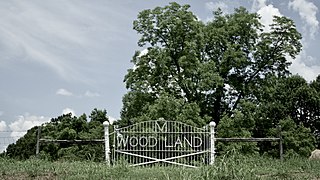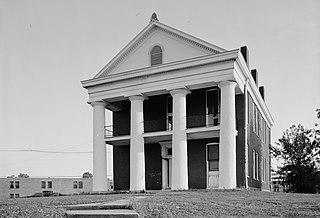Related Research Articles

Jefferson County is a county located in the U.S. state of Mississippi; its western border is formed by the Mississippi River. As of the 2020 census, the population was 7,260, making it the fourth-least populous county in Mississippi. Its first county seat was located at Old Greenville until 1825, which no longer exists, before moving to Fayette. The county is named for U.S. President Thomas Jefferson.

Claiborne County is a county located in the U.S. state of Mississippi. As of the 2020 census, the population was 9,135. Its county seat is Port Gibson. The county is named after William Claiborne, the second governor of the Mississippi Territory.

The Beauvoir estate, built in Biloxi, Mississippi, along the Gulf of Mexico, was the post-war home (1876–1889) of the former President of the Confederate States of America Jefferson Davis. The National Park Service designated the house and plantation as a National Historic Landmark.
The Natchez District was one of two areas established in the Kingdom of Great Britain's West Florida colony during the 1770s – the other being the Tombigbee District. The first Anglo settlers in the district came primarily from other parts of British America. The district was recognized to be the area east of the Mississippi River from Bayou Sara in the south and Bayou Pierre in the north.

Holly Grove Plantation House was built c. 1830 by Noel and Jane Killingsworth near Red Lick, Mississippi, and dismantled and reconstructed 70 miles (110 km) to the north in Hinds County, Mississippi, in 1990. The Killingsworths lived there with their children and grandchildren, including Sarah Ellen Grafton. They sent her and their other daughters to Nazareth Academy in Bardstown, Kentucky.

Longwood, also known as Nutt's Folly, is a historic antebellum octagonal mansion located at 140 Lower Woodville Road in Natchez, Mississippi, United States. Built in part by enslaved people, the mansion is on the U.S. National Register of Historic Places, and is a National Historic Landmark. Longwood is the largest octagonal house in the United States.

Church Hill is a small unincorporated community in Jefferson County, Mississippi, United States. It is located eight miles east of the Mississippi River and approximately 18 miles north of Natchez at the intersection of highway 553 and Church Hill Road. Church Hill was a community of wealthy cotton planters and enslaved people before the American Civil War. Soil erosion, which had been going on since well before the Civil War, caused the area to decline into a poor farming community with none of the land under cultivation by 1999. The area is remarkable because its antebellum buildings are mostly intact with few modern buildings having been built.

Rodney is a ghost town in Jefferson County, Mississippi, United States. Most of the buildings are gone, and the remaining structures are in various states of disrepair. The town floods regularly, and some of the buildings have extensive flood damage. The Rodney History And Preservation Society is restoring Rodney Presbyterian Church. Damage to the church's facade from the American Civil War has been maintained as part of the historical preservation including a replica cannonball embedded above the balcony windows. The Rodney Center Historic District is listed on the National Register of Historic Places.
Haller Nutt (1816–1864) was an American Southern planter. He was a successful cotton planter and plantation owner in Mississippi. He developed a strain of cotton that became important commercially for the Deep South.

Thornhill is a historic plantation near Forkland, Alabama. The Greek Revival main house was built in 1833 by James Innes Thornton. The house was placed on the National Register of Historic Places on May 10, 1984.
A Mississippi Landmark is a building officially nominated by the Mississippi Department of Archives and History and approved by each county's chancery clerk. The Mississippi Landmark designation is the highest form of recognition bestowed on properties by the state of Mississippi, and designated properties are protected from changes that may alter the property's historic character. Currently there are 890 designated landmarks in the state. Mississippi Landmarks are spread out between eighty-one of Mississippi's eighty-two counties; only Issaquena County has no such landmarks.
Red Lick is an unincorporated community located in Jefferson County, Mississippi. Red Lick is approximately 5 miles (8.0 km) southeast of Lorman on Mississippi Highway 552.

The Woodland Plantation is a historic Southern plantation near Church Hill, Jefferson County, Mississippi. It retains its original antebellum 230 acre size, and has the tradition of primarily supplying hay to the area cattle. It also has a pecan orchard.
Rosswood is a historic Southern plantation located off of Mississippi Highway 552, in Lorman, Jefferson County, Mississippi, USA. It was listed on the National Register of Historic Places in 1978.
The Civil War Trust's Civil War Discovery Trail is a heritage tourism program that links more than 600 U.S. Civil War sites in more than 30 states. The program is one of the White House Millennium Council's sixteen flagship National Millennium Trails. Sites on the trail include battlefields, museums, historic sites, forts and cemeteries.

Oakland College was a private college near Rodney, Mississippi. Founded by Jeremiah Chamberlain in 1830, the school was affiliated with the Presbyterian Church. It closed during Reconstruction, and some of its former campus is now part of the Alcorn State University Historic District.
Petit Gulf cotton was a cotton hybrid patented by planter Rush Nutt at his Laurel Hill Plantation in Rodney, Mississippi, in 1833. It was named "Petit Gulf" for the bend of the Mississippi River where it was grown. It proved more resistant than the green seed cotton from Georgia as long as planters followed the breeding process used in Rodney. Indeed, it was said to be less likely to harbor diseases and rot than other breeds of cotton. Moreover, it was easier to pick with a human hand, thus leading to greater productivity.
Rush Nutt (1781–1837) was a Mississippian planter, physician, and scientist. He was the founder of Laurel Hill Plantation and discovered Petit Gulf cotton. He is a former justice of the Jefferson County court in Mississippi.

Mississippi Highway 552 (MS 552) is a state highway in the U.S. state of Mississippi that travels through Claiborne and Jefferson counties. The highway, consisting of two segments connected via McBride Road, connects Alcorn State University with Lorman, Natchez Trace Parkway and U.S. Route 61 (US 61) and other small communities in northern Jefferson County.

Mississippi Highway 553 (MS 553) is a state highway in Adams and Jefferson counties in southwestern Mississippi. The highway runs from U.S. Route 61 (US 61) in Stanton, loops to the west around US 61 and the Natchez Trace Parkway to Fayette, and extends further north to Harriston. Within Jefferson County, MS 553 passes numerous locations on the National Register of Historic Places.
References
- ↑ Johnson, Walter (2013). River of Dark Dreams. Cambridge, MA: Harvard University Press. ISBN 978-0-674-04555-2.
- 1 2 3 4 Library of Congress: Laurel Hill Plantation House, Rodney & Red Licks Roads, Rodney, Jefferson County, MS
- ↑ "Historic American Buildings Survey: Laurel Hill Plantation House, Rodney & Red Licks Roads, Rodney, Jefferson County, MS". Library of Congress.
- ↑ Library of Congress: View from north - Laurel Hill Plantation House, Rodney & Red Licks Roads, Rodney, Jefferson County, MS
- ↑ "National Register Information System". National Register of Historic Places . National Park Service. July 9, 2010.